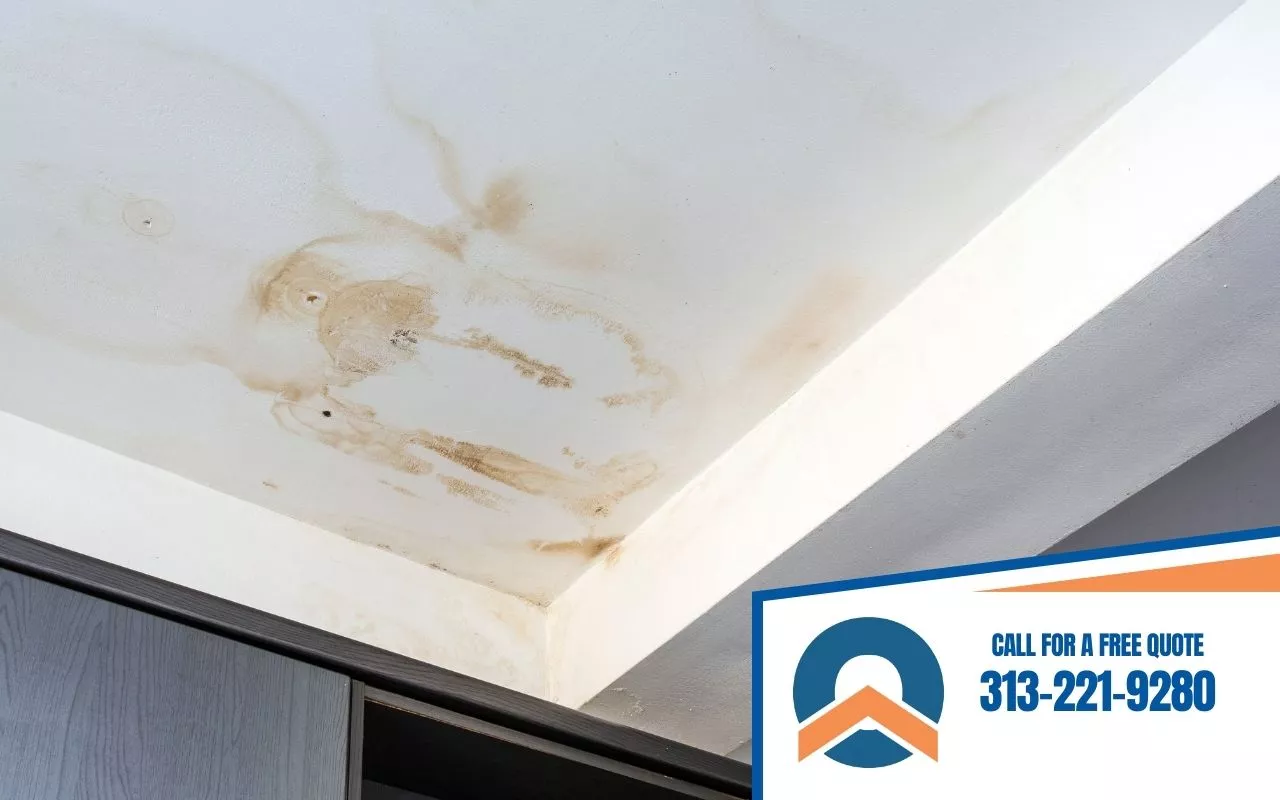In Detroit and across southeast Michigan, we get our fair share of rough weather. Snowstorms, heavy rain, freeze-thaw cycles, hail, and summer heat all do a number on your roof. Asphalt shingles take the brunt of it—and over time, even a tiny breach can become a big problem.
- What Causes Ceiling Stains?
- The Hidden Damage Above the Stain
- Why Painting Over It Is a Mistake
- How to Tell If the Leak Is Active
- What a Professional roof inspection Includes
- Why It’s Important to Act Fast
- How to Prevent Future Ceiling Stains
- Frequently Asked Questions (FAQ)
- Call Now—Don’t Let That Stain Spread
A quiet drip. A slow spread. A faint yellow ring on the ceiling.
It might seem small. It might even feel like something you can ignore, patch up, or paint over. But here’s the truth:
“A ceiling stain isn’t just a mark—it’s a message.”
— Cisco Roofing Systems
And the message?
There’s trouble above.
If you’ve spotted a ceiling stain, it means that breach has already happened. This article will walk you through why that stain matters, what it could mean, and what you should do next.
What Causes Ceiling Stains?
A ceiling stain is caused by water intrusion, plain and simple. But the source of that water isn’t always obvious. Here are some of the most common roofing-related culprits:
- Damaged shingles: Cracked, curling, or missing shingles allow water to slip beneath the surface.
- Worn flashing: The metal seals around chimneys, vents, and skylights can corrode or lift over time.
- Leaky valleys: Where two roof slopes meet, valleys can collect debris and channel water into weak spots.
- Ice dams: In winter, melted snow refreezes along roof edges, pushing water back under the shingles.
- Poor attic ventilation: Trapped heat and moisture can rot wood and create condensation, soaking insulation and ceilings below.
- Clogged gutters: When gutters overflow, water backs up onto the roof, weakening the protective layers.
These issues rarely fix themselves. And once moisture breaks through, the damage doesn’t stop at the roof.
The Hidden Damage Above the Stain
By the time a ceiling stain appears inside your home, water has already passed through several layers:
- Shingles and underlayment
- Roof decking
- Attic insulation
- Drywall or plaster
What’s left behind? Not just discoloration. You could be looking at:
- Saturated insulation (which loses its ability to regulate temperature)
- Wood rot in rafters, joists, or sheathing
- Mold and mildew between ceiling layers
- Electrical risks if water reaches wires or fixtures
- Decreased indoor air quality (especially for kids or those with respiratory conditions)
And worst of all? Most homeowners don’t see or feel any symptoms—until the ceiling stain shows up.
Why Painting Over It Is a Mistake
We get it. No one wants to look up and see a brown blotch on the ceiling. It’s ugly, embarrassing, and unsettling. But painting over it won’t fix the issue.
That stain is a symptom, not the cause.
You wouldn’t silence a smoke alarm and ignore the fire. And you shouldn’t ignore what that stain is telling you, either.
How to Tell If the Leak Is Active
Sometimes, a ceiling stain is dry. Maybe it came from an old storm, and the leak has since stopped. Other times, it’s still active—and getting worse.
Here’s how to tell:
- Touch the spot: If it feels soft, damp, or cold, the leak is likely ongoing.
- Check after rain: Does the stain grow darker or expand after a storm? That’s a clear sign of water entry.
- Look for bubbling paint: This means water is trapped beneath the surface.
- Inspect the attic (if safe): Look for wet insulation, wood discoloration, or the source of a drip.
Still not sure? That’s where a professional roof inspection comes in.
What a Professional Roof Inspection Includes
At Cisco Roofing Systems, we offer free, thorough roof inspections across the Detroit area. When we inspect a roof for a ceiling stain issue, here’s what we look for:
- Compromised or missing shingles
- Rusted or lifted flashing
- Clogged or damaged gutters and downspouts
- Signs of attic moisture, mold, or mildew
- Water trails on decking or insulation
- Ice dam damage (in colder months)
- Roof age and prior repair quality
Our team doesn’t just fix the surface—we trace the leak to the source, explain your options, and provide a clear, pressure-free quote.
Why It’s Important to Act Fast
Water damage is progressive. The longer it goes unaddressed, the worse (and more expensive) it gets.
Here’s what happens over time:
- Week 1–2: Water spreads, insulation begins to compress
- Week 3–4: Wood begins to weaken, drywall softens
- Month 2+: Mold begins to grow, structural integrity is compromised
- Month 3+: Potential for ceiling collapse, large-scale interior damage
What might’ve been a $500 repair becomes a $5,000 headache. That’s why early action saves more than just your ceiling—it saves your wallet and your peace of mind.
How to Prevent Future Ceiling Stains
You can’t stop every storm, but you can strengthen your home’s first line of defense: your roof.
Here’s a checklist to help prevent ceiling stains and leaks:
- Get your roof inspected annually
- Clean your gutters at least twice a year
- Trim tree branches near your roofline
- Check attic insulation and ventilation
- Replace missing or damaged shingles promptly
- Schedule a professional inspection after major storms
Frequently Asked Questions (FAQ)
Call Now—Don’t Let That Stain Spread
At Cisco Roofing Systems, we’ve seen it all. And we’ve fixed it all. Whether it’s one ceiling stain or a dozen, we’ll find the cause, stop the leak, and protect your home like it’s our own. From roof repairs to roof replacement, we can ensure your roof will last.
We serve Detroit, MI and surrounding communities with fast, honest, professional roofing services.
Call today at 313-221-9280
Your roof won’t fix itself.
Let us handle it—so you can look up and feel safe again.



Leave A Comment
You must be <a href="https://roofmi.com/wp-login.php?redirect_to=https%3A%2F%2Froofmi.com%2Fwhy-ceiling-stains-mean-more-than-you-think%2F">logged in</a> to post a comment.